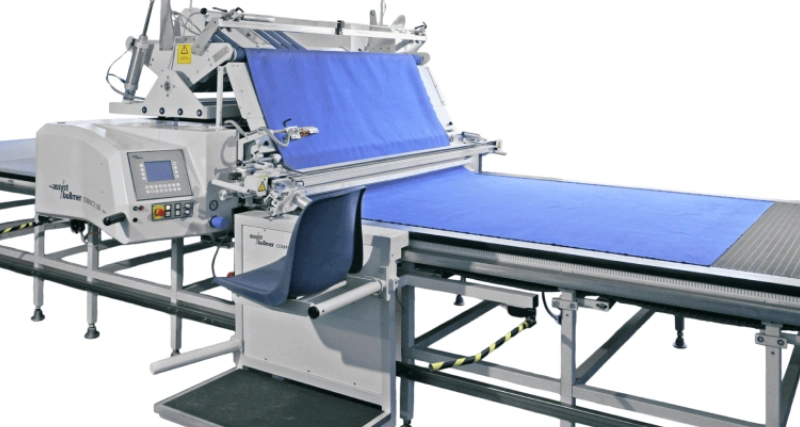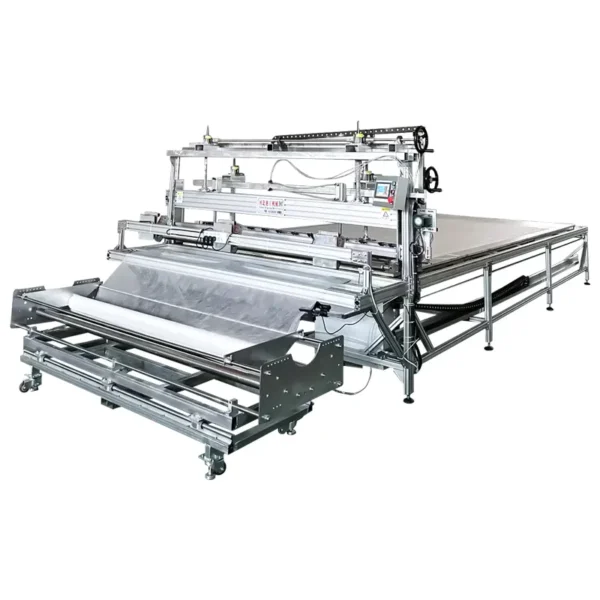As a manufacturer of spreading machines, we understand the critical role that the right spreading technology plays in industries ranging from textiles to automotive production. Whether you’re working with fabric, paper, or rubber, choosing the right type of spreading machine can significantly impact the efficiency and quality of your production process. In this article, we’ll dive into the different types of spreading machines available, explore their features, and discuss how they can help manufacturers and customers optimize their operations.
What Is a Spreading Machine?

Before we jump into the types, let’s first define what a spreading machine is and why it’s so important. Simply put, a spreading machine is a device used to unfold, layer, or spread materials, most commonly fabrics, to a specific width or configuration. These machines are crucial in industries where large amounts of material need to be handled uniformly, such as in the textile, automotive, and paper industries.
Think about it: when you’re working with fabrics or other delicate materials, the last thing you want is uneven tension or inconsistent layers. A good spreading machine helps ensure that the material is spread out in a smooth, uniform manner, reducing errors and improving the overall quality of the product.
Rotary Spreading Machines: The Industry Standard
Rotary spreading machines are one of the most commonly used types in textile manufacturing. They are particularly popular due to their efficiency and versatility. These machines use rotating rollers to pull and spread the fabric, which helps reduce wrinkles and distortions during the process.
The key advantage of rotary spreading machines is their ability to handle large volumes of material at high speeds without compromising on quality. The rotary motion also ensures even tension, preventing any part of the fabric from becoming too tight or too loose.
As a manufacturer, we have seen firsthand how rotary spreaders increase productivity and reduce the time spent on material handling. With rotary spreading machines, the material flows smoothly and evenly, ensuring that the final product meets high-quality standards. This type of spreading machine is ideal for large-scale operations where speed is a top priority.
Non-Rotary Spreading Machines: Precision and Control
Unlike rotary spreaders, non-rotary spreading machines use a different mechanism to spread materials. These machines typically rely on a series of rollers, belts, or combs that slowly guide the material across a surface, rather than using a rotating motion. Non-rotary spreaders offer precise control over the spreading process, which is particularly useful when dealing with delicate or complex materials.
For manufacturers dealing with high-end fabrics or materials that require special attention, non-rotary spreading machines are an excellent choice. These machines offer better control over the spreading process, allowing for a more precise and even distribution. However, they tend to be slower than rotary machines, which means they may not be the best choice for high-volume production lines.
In our experience, non-rotary machines are often used in specialized settings where the material quality is more important than speed. Customers who prioritize precision, such as those in the luxury fashion industry or specialized textile applications, tend to favor non-rotary spreading machines.
Manual vs. Automatic Spreading Machines: Which One Is Right for You?
When deciding on the right type of spreading machine, one of the most important factors to consider is whether to go with a manual or automatic model. Both types have their pros and cons, depending on the needs of your production line.
Manual Spreading Machines: These machines require operators to control the spread of the material, offering greater flexibility but demanding more labor input. Manual spreaders are typically more affordable and suitable for smaller production runs where precision and control are crucial.
Automatic Spreading Machines: On the other hand, automatic spreading machines offer enhanced speed and consistency. These machines can spread material with minimal human intervention, making them ideal for large-scale operations where speed and volume are top priorities. They also reduce the potential for human error, improving overall efficiency.
From a manufacturer’s perspective, automatic spreading machines are a game-changer when it comes to reducing labor costs and increasing throughput. However, for customers with more specialized needs, manual machines can still provide the level of customization and hands-on control that is required.
Fabric Spreading Machines: Optimizing Material Usage
Fabric spreading machines are specifically designed for the textile industry, where they help ensure that fabric is spread evenly across the production line. These machines are used for a variety of purposes, from preparing fabric for cutting to creating perfectly flat rolls of fabric for further processing.
The primary advantage of fabric spreading machines is their ability to reduce fabric waste. By ensuring that the fabric is spread out evenly, manufacturers can optimize material usage and minimize wastage. This is particularly important in the textile industry, where fabric costs can make up a significant portion of production expenses.
In our experience, fabric spreading machines are a must-have for textile manufacturers who want to increase material efficiency and reduce costs. They allow for more precise cutting, which ultimately leads to better-quality products and less waste.
Double Spreader Machines: For Enhanced Productivity
Double spreaders are an excellent choice for manufacturers looking to maximize productivity while ensuring quality. These machines use two spreaders that work in tandem to double the spreading capacity, making them ideal for high-volume production lines.
The main advantage of double spreaders is their ability to process two layers of fabric simultaneously, effectively cutting down on the time required for material handling. This makes them particularly useful in industries where high throughput is essential, such as automotive or upholstery manufacturing.
From a reliability standpoint, double spreaders have received positive feedback from both wholesalers and end-users. Customers who need to handle large quantities of material quickly and efficiently often find that double spreaders offer the perfect balance of speed and quality.
Air-Jet Spreading Machines: The Modern Solution for Delicate Fabrics
Air-jet spreading machines represent one of the latest advancements in spreading technology. These machines use a high-speed stream of air to spread the material, which helps reduce friction and prevent damage to delicate fabrics.
This type of spreading machine is perfect for lightweight or delicate materials that require special handling. The air-jet system is gentle on the fabric while still providing an even spread. This makes it an excellent choice for industries dealing with fine fabrics, such as fashion or luxury textiles.
One of the key benefits of air-jet spreaders is that they reduce the risk of fabric distortion or damage. This makes them a favorite among manufacturers who prioritize fabric integrity and quality. As we’ve seen from customer feedback, air-jet spreading machines have proven to be reliable, efficient, and cost-effective for delicate applications.
High-Speed Spreading Machines: Meeting the Demand for Speed
For manufacturers working in industries where time is of the essence, high-speed spreading machines are the ideal choice. These machines are designed to handle high volumes of material at an accelerated pace, without sacrificing the quality of the spread.
High-speed spreaders are often used in industries like automotive and upholstery, where large quantities of fabric need to be handled quickly and efficiently. These machines can process materials at speeds that would be impossible to achieve manually, making them a game-changer for manufacturers under tight production deadlines.
Customers consistently report that high-speed spreading machines help them meet their production quotas while maintaining product quality. By investing in high-speed spreaders, manufacturers can ensure that they stay ahead of the competition and meet the ever-growing demand for fast, reliable production.
What to Look for When Buying a Spreading Machine
Choosing the right spreading machine is not just about picking the most expensive or advanced model. It’s about finding a machine that suits your specific production needs. Here are a few key factors to consider:
- Material Compatibility: Different types of spreaders are suited for different materials. Be sure to choose a machine that works well with the materials you plan to use.
- Speed and Efficiency: Consider how quickly the machine can process materials and whether that aligns with your production schedule.
- Ease of Use: Whether manual or automatic, the machine should be easy to operate and maintain.
- Customization Options: Some spreaders offer adjustable settings for different fabric types, widths, and tension levels.
- Cost and Return on Investment: Always factor in the total cost of ownership, including maintenance and energy consumption.
As manufacturers ourselves, we understand the importance of making the right investment. We recommend that buyers carefully evaluate their needs before purchasing a spreading machine to ensure that they select the best option for their business.
Conclusion
Choosing the right spreading machine is crucial to ensuring smooth, efficient production processes in industries ranging from textiles to automotive manufacturing. Whether you need a rotary spreader for high-speed operations or a non-rotary machine for more delicate fabrics, the right equipment can make all the difference.
As a Spreading Machine manufacturer, we take pride in offering a wide variety of spreading machines that cater to different production needs. From high-speed spreaders to precision machines, we’re committed to providing the best possible solutions for our customers. By understanding the different types of spreading machines and how they fit into your production process, you can make a more informed decision that improves both efficiency and product quality.
FAQs
What is the difference between rotary and non-rotary spreading machines?
Rotary spreading machines use a rotating mechanism to spread materials quickly and evenly, while non-rotary machines rely on a series of rollers or belts for precise control.
Are automatic spreading machines more efficient than manual ones?
Yes, automatic spreading machines can handle higher volumes of material with less human intervention, making them ideal for large-scale operations.
What materials can be spread using air-jet spreading machines?
Air-jet spreading machines are best for delicate or lightweight materials, as they gently spread fabric without causing damage.
How do double spreading machines increase productivity?
Double spreaders use two spreaders simultaneously, allowing for faster material handling and doubling the output rate.
How do I choose the right spreading machine for my business?
Consider factors like material type, speed, ease of use, and cost to determine the best machine for your production needs.
Are spreading machines easy to maintain?
Most modern spreading machines are designed with ease of maintenance in mind. Regular cleaning and servicing can keep them running smoothly for years.


